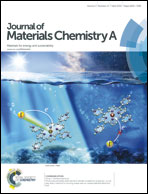Two (3,6)-connected porous metal–organic frameworks based on linear trinuclear [Co3(COO)6] and paddlewheel dinuclear [Cu2(COO)4] SBUs: gas adsorption, photocatalytic behaviour, and magnetic properties†
Abstract
Presented here are two novel (3,6)-connected porous metal–organic frameworks (MOFs) formulated as [Co3(BPT)2(DMF)(bpp)]·DMF (1) and [(CH3)2NH2][Cu(BPT)]·DMF·2H2O (2) (H3BPT = biphenyl-3,4′,5-tricarboxylic acid, bpp = 1,3-bis(4-pyridyl)propane). Compound 1 has a 3D neutral framework decorated with one-dimensional hydrophobic channels (diameter 8.778(7) Å) while compound 2 has an anionic framework containing one-dimensional hydrophilic channels with a diameter of 8.688(5) Å. Interestingly, compound 1 shows promising visible-light-driven photocatalytic activity for the degradation of RhB while compound 2 exhibits high intake capacities for CO2 (11.90 wt%) and H2 (1.23 wt%), respectively. In addition, temperature-dependent magnetic susceptibility measurements indicated that both 1 and 2 display dominant antiferromagnetic coupling among the adjacent Co(II)/Cu(II) centers.
![Graphical abstract: Two (3,6)-connected porous metal–organic frameworks based on linear trinuclear [Co3(COO)6] and paddlewheel dinuclear [Cu2(COO)4] SBUs: gas adsorption, photocatalytic behaviour, and magnetic properties](/en/Image/Get?imageInfo.ImageType=GA&imageInfo.ImageIdentifier.ManuscriptID=C4TA06537A&imageInfo.ImageIdentifier.Year=2015)

 Please wait while we load your content...
Please wait while we load your content...